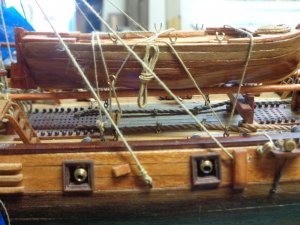I have been getting some fuzzy lines lately as a norm I wax all the lines, lately I have tried soaking them in water diluted with white glue then waxing. I have allot of different types of line in the supply locker hemp, synthetic, treated, untreated, ect not a big fan of the newer synthetic stuff so I order from several different companies. Difference in quality could be the problem ? I do have some really old line which really looks good but will fuzz up even after waxing. Bottom line is I need to try to treat some of the lines already rigged, and find a solution for the new line. any help or Ideas would be greatly appreciated. Notice the fuzz in the outboard hull lines in the photo MOG









